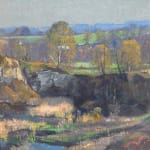Roy C. Nuse 1885-1975
The Quarry, Autumn
Oil on board
12 x 16 inches
30.5 x 40.6 cm
Framed dimensions: 18.5 x 22.5 inches
30.5 x 40.6 cm
Framed dimensions: 18.5 x 22.5 inches
For many of the Pennsylvania Impressionists, quarries were a subject they returned to paint time and again. Daniel Garber's paintings of quarries are perhaps some of the most famous. Thus...
For many of the Pennsylvania Impressionists, quarries were a subject they returned to paint time and again. Daniel Garber's paintings of quarries are perhaps some of the most famous. Thus it is not surprising that Roy Nuse painted The Quarry, Autumn, as Garber was one of his most influential mentors and Nuse was also deeply entrenched in the ideas and subject matter of the New Hope School.
The Quarry reflects Nuse's interest in depicting how change, particularly industrialization, affected the landscape. The changing of the autumn leaves gave the artist an opportunity to use the strong colors he loved. The striations in the rocks and their differences from the rolling green hills of the countryside not only make for an interesting composition but also demonstrate Nuse's mastery of painting such forms.
Roy Nuse was a prolific artist, who was well respected by his peers and a beloved teacher at the Pennsylvania Academy of the Fine Arts. He began his artistic training in Cinncinnati, where he was born, under the tutelage of Frank Duveneck. From Duvenek, Nuse learned the importance of expert draftsmanship and the value of a strong, dark palette. When his parents moved to Bucks County, Pennsylvania, Nuse followed with his own family. He enrollled at the Pennsylvania Academy, where he met Daniel Garber.
Garber would assert strong influence on Nuse's artistic style. Under Garber, Nuse refined his sense of color and mastered his draftsmanship. He practiced plein air painting and advocated instilling the landscape with emotion and mood.
During his lifetime Nuse exhibited at the Corcoran Gallery of Art, Washington, DC; the Art Institute of Chicago; the National Academy of Design, New York; and the Pennsylvania Academy of the Fine Arts, where he also taught portraiture and figure study for over twenty-nine years.
The Quarry reflects Nuse's interest in depicting how change, particularly industrialization, affected the landscape. The changing of the autumn leaves gave the artist an opportunity to use the strong colors he loved. The striations in the rocks and their differences from the rolling green hills of the countryside not only make for an interesting composition but also demonstrate Nuse's mastery of painting such forms.
Roy Nuse was a prolific artist, who was well respected by his peers and a beloved teacher at the Pennsylvania Academy of the Fine Arts. He began his artistic training in Cinncinnati, where he was born, under the tutelage of Frank Duveneck. From Duvenek, Nuse learned the importance of expert draftsmanship and the value of a strong, dark palette. When his parents moved to Bucks County, Pennsylvania, Nuse followed with his own family. He enrollled at the Pennsylvania Academy, where he met Daniel Garber.
Garber would assert strong influence on Nuse's artistic style. Under Garber, Nuse refined his sense of color and mastered his draftsmanship. He practiced plein air painting and advocated instilling the landscape with emotion and mood.
During his lifetime Nuse exhibited at the Corcoran Gallery of Art, Washington, DC; the Art Institute of Chicago; the National Academy of Design, New York; and the Pennsylvania Academy of the Fine Arts, where he also taught portraiture and figure study for over twenty-nine years.
Provenance
Estate of the artist;Samuel T. Freeman & Co., June 27, 2005, lot 200;
Private collection, Pennsylvania;
26
of
26
Please join our mailing list
* denotes required fields
We will process the personal data you have supplied in accordance with our privacy policy (available on request). You can unsubscribe or change your preferences at any time by clicking the link in our emails.



